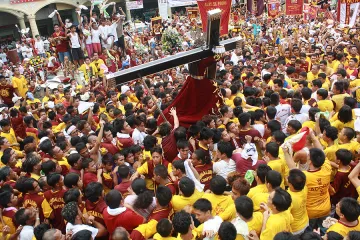CNA Newsroom, Jan 10, 2023 / 11:30 am
More than 100,000 faithful gathered to venerate the “Black Nazarene” in the Philippines after a two-year suspension of the traditional procession due to the COVID-19 pandemic restrictions.
The venerated image of the Black Nazarene was processed Jan. 8 from the Quirino Grandstand to St. John the Baptist church in Manila, also known as the “Church of Quiapo,” with an estimated 103,277 faithful participating.
This year, the procession — also called the “Translation” or “Walk of Faith” — took place from 1:30 a.m to 4 a.m. local time.
These two and a half hours contrasted with the 22 hours the event used to last before the pandemic, bringing together millions of Catholic faithful.
This procession is one of the most important religious celebrations in the Philippines, the only country with a Catholic majority in Asia, accounting for approximately 82% of the entire population.
The origin of the Black Nazarene dates back to 1607, when the wooden image representing Christ bent under the weight of the cross was transported on a ship from Mexico to Manila. According to tradition, during the voyage the ship caught fire but the image was miraculously spared and was only blackened.
Two years after the procession was suspended due to the pandemic, Catholics feared that the restrictions would again be imposed in 2023.
However, on Jan. 3, the Church of Quiapo received authorization from the civil authorities to resume the tradition under certain conditions.
According to Asia News, Father Earl Allyson Valdez, the pastor of Quiapo, explained that this year instead of kissing the Black Nazarene the faithful could simply approach and touch the revered image to avoid contagion.
This story was first published by ACI Prensa, CNA’s Spanish-language news partner. It has been translated and adapted by CNA.






